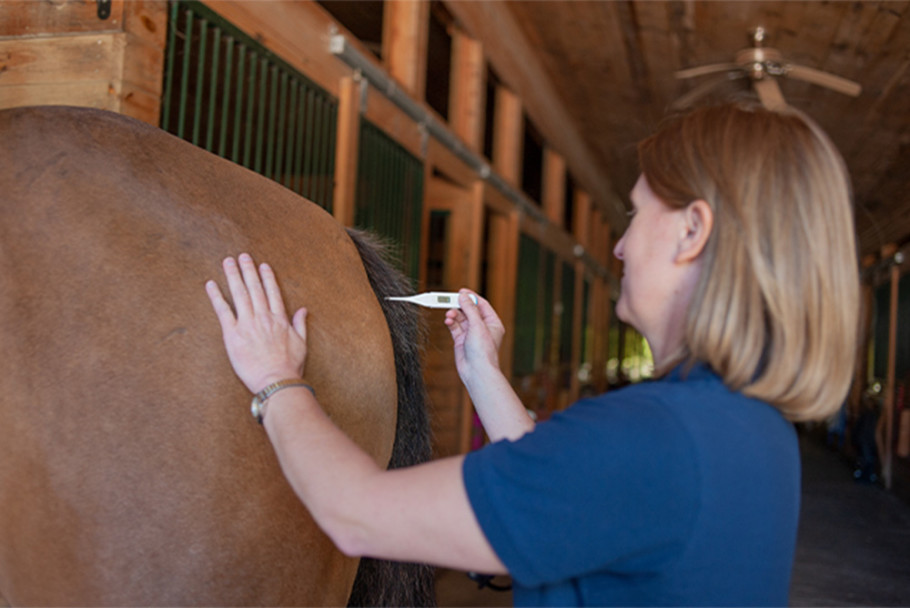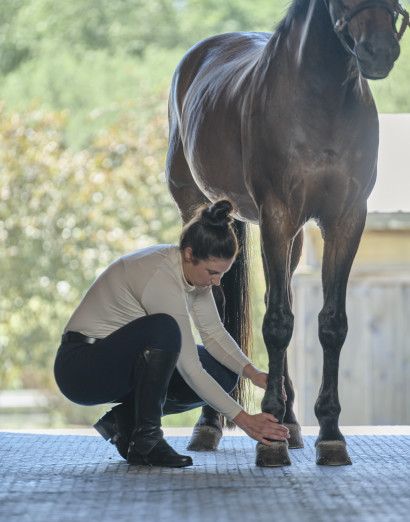How to Take Your Horse's Vital Signs
By: Dr. Lydia Gray | Updated March 21, 2025 by SmartPak Equine

Knowing how to measure your horse’s temperature (T), pulse (P) and respiration (R) is a basic barn skill every horse owner should master. Typical normal vital sign ranges for horses are:
- T = 99.5 - 100.5°
- P = 28 - 42 beats per minute
- R = 8 -12 breaths per minute
It's important to figure out what is normal for YOUR horse. Let’s start with Temperature.
How to Measure Your Horse's Temperature

Digital vs glass thermometers
Every barn should have at least one thermometer. There are two kinds of large animal rectal thermometers, and it’s a good idea to have at least one of each:
- a digital thermometer, and
- a glass thermometer.
Both have their pros and cons. For example, a digital thermometer only requires 60 seconds to take a reading but you have to hold on to it the whole time or the horse may push it out. You also have to remember to turn it on and let it calibrate before using.
A glass thermometer (which requires at least two minutes) can be left in the horse’s rectum while you perform the rest of your exam but you have to attach a cord and clip first. You must also shake the mercury down beforehand.
Taking your horse's temperature step-by-step
Both require some lubrication before insertion and a handler is helpful. Be safe! To take your horse’s temperature:
- Stand to one side and gently move the horse’s tail out of the way.
- Slowly insert the thermometer nearly all the way inside, allowing the horse to adjust. Take your time and be patient. The digital thermometer will beep when it is ready but the glass thermometer has to be timed.
- Remove either slowly and read the number.
- Clean the thermometer by wiping it off with a soapy damp cloth then remember to write the temperature down.
“Temp” your horse several times, at different parts of the day, to determine what is normal for them.
Measuring Your Horse’s Pulse
Moving on to taking your horse’s pulse or heart rate, there are three ways to measure this.
- You can use your fingers to feel for a pulse in an artery
- A stethoscope to listen to the heart
- A heart rate monitor
Where to check the pulse on your horse

There are several places to check your horse’s pulse, such as the inside of the jaw, the inside of the front leg above the knee, the outside of the hind leg, and underneath the tail. But these can be harder to find than the digital pulse:
- Have someone hold your horse or tie them.
- Squat next to their left front leg, facing forward.
- With your right palm touching the back of the leg, thumb to the outside and fingers to the inside, start at the knee and run your hand down the leg until you reach the ankle, or fetlock.
- Very lightly press your thumb and middle finger against the leg, at the level of the fetlock.
- Now begin to slowly slide your entire hand backward, until your thumb and middle finger nearly come off the back of the leg.
- Experiment with light, moderate, and heavy pressure inward until you feel the pulse.
- Count the pulses over 15 seconds and multiply by four.
Tip: Don’t use the tip of your thumb/finger, where the nail is. Press on the leg just past the last joint in your thumb/finger.
How to Count Your Horse’s Respiratory Rate

To take your horse’s heart rate using a stethoscope (which every barn should have), place the buds in your ears so they point forward, slide the head forward underneath your horse’s elbow on the left side until you hear the heart beat, and count only one of the sounds (so lub-DUB is one beat) over a 15 second period, again multiplying by four.
You may have to experiment with how hard to press the stethoscope head against the chest to be able to hear clearly. Using a heart rate monitor is even easier, as the number of beats per minute is displayed on a separate watch.
Counting your horse’s respiratory rate, or breaths per minute, is the final vital sign. Again, this can be done in three ways:
- by watching the nostrils flare,
- by watching the flank rising and falling, or
- by listening to the trachea (or lungs) with a stethoscope.
The first two methods can be done outside the stall or at least without touching the horse and may provide a more accurate resting respiratory rate. Remember that one breath is a complete cycle in (inhalation) and out (exhalation). Because the horse’s normal respiratory rate is so low, count for 30 seconds or a whole minute to get a more accurate reading.
Video on Taking Your Horse's Vital Signs
In this video, Dr. Gray demonstrates how to take each of your horse's vital signs.